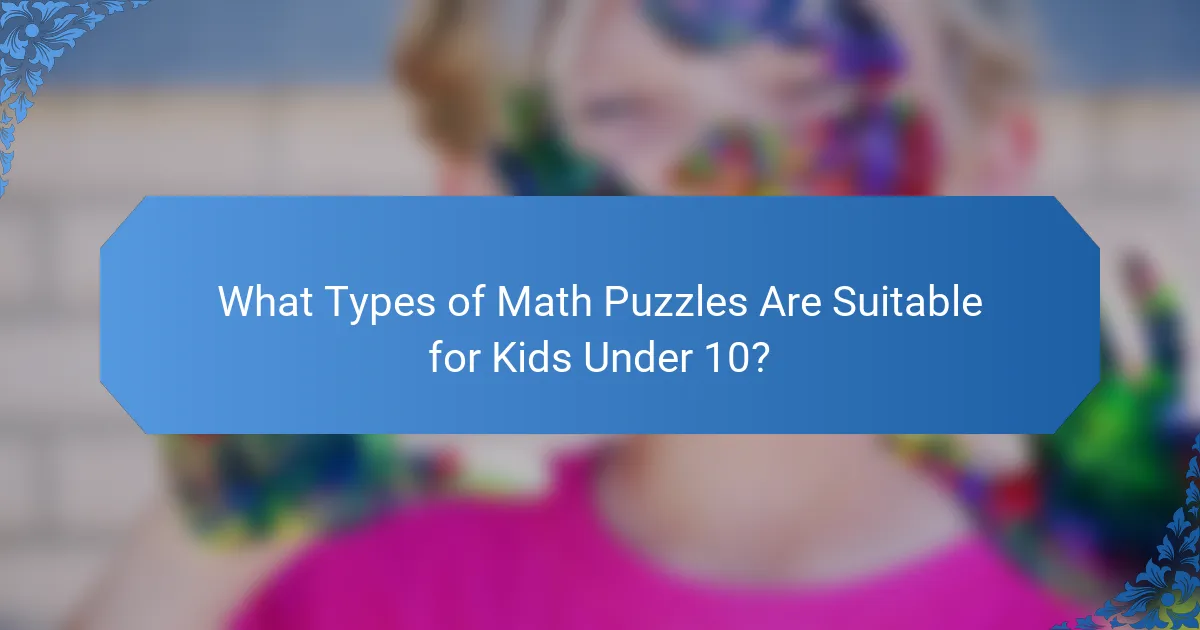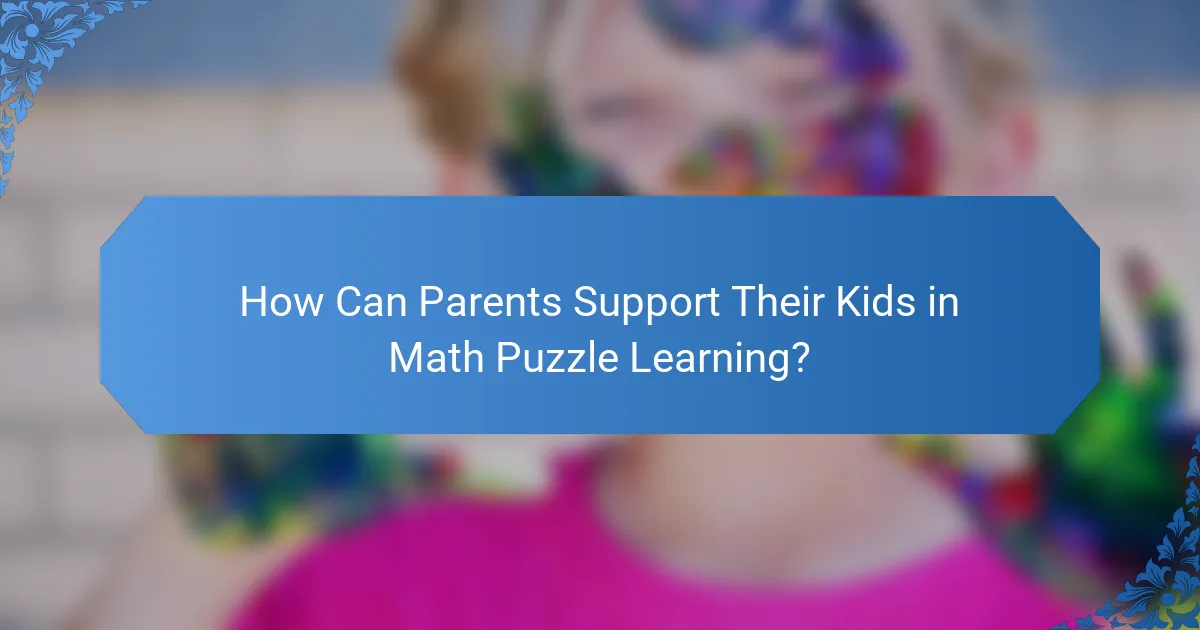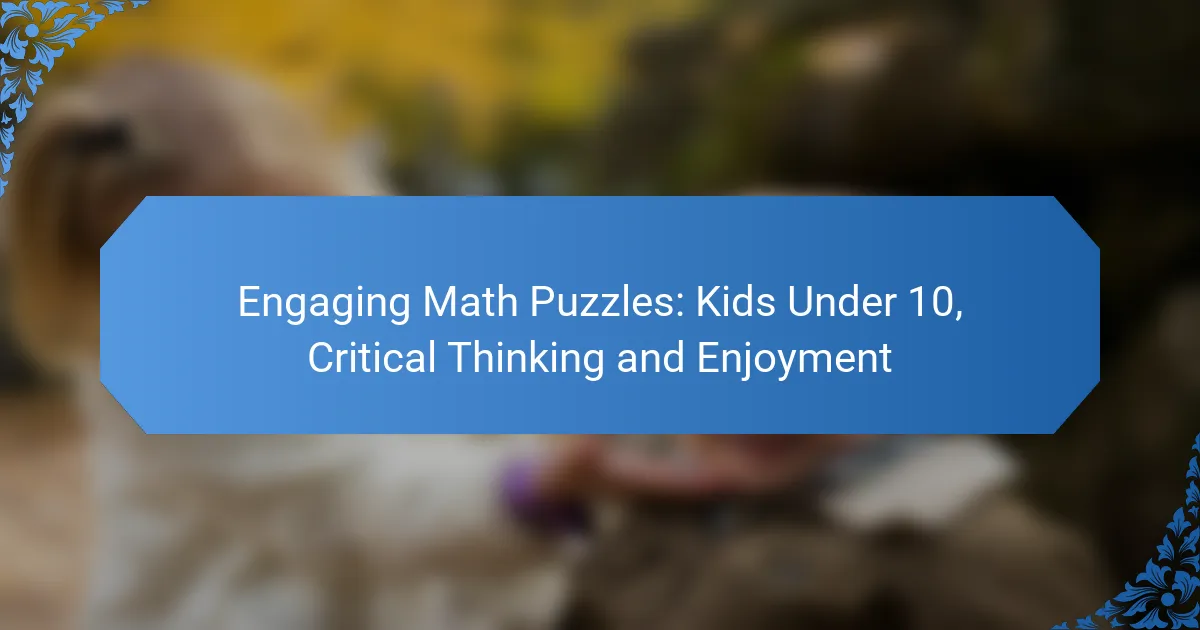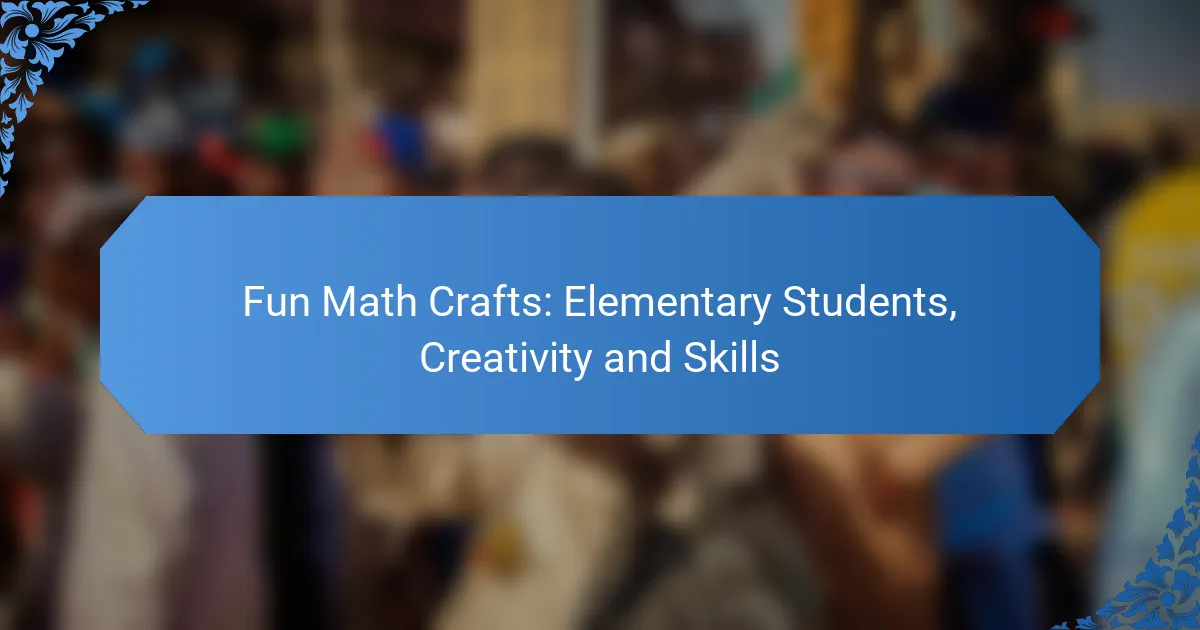Engaging math puzzles are a fantastic way to enhance critical thinking skills in children under 10, encouraging them to analyze, decide, and solve problems creatively. By incorporating age-appropriate challenges such as number puzzles and logic games, these activities not only stimulate cognitive development but also make learning enjoyable and interactive.

How Can Engaging Math Puzzles Improve Critical Thinking in Kids?
Engaging math puzzles can significantly enhance critical thinking in kids by challenging them to analyze situations, make decisions, and solve problems creatively. These activities stimulate cognitive development and encourage children to think independently while having fun.
Enhances problem-solving skills
Math puzzles require children to identify problems and explore various strategies to find solutions. This process helps them develop a systematic approach to problem-solving, which is essential in both academic and real-life situations. For example, puzzles that involve finding patterns or sequences can sharpen their analytical skills.
Encouraging kids to tackle different types of puzzles can expose them to multiple problem-solving techniques. This variety helps them understand that there is often more than one way to reach a solution.
Encourages logical reasoning
Logical reasoning is a critical component of math puzzles, as they often require kids to make deductions based on given information. Engaging with these puzzles helps children learn to construct logical arguments and draw conclusions from premises. For instance, puzzles that involve sorting or categorizing objects can enhance their ability to think logically.
By regularly practicing logical reasoning through puzzles, children can improve their ability to think critically in other subjects, such as science and reading comprehension.
Boosts creativity
Math puzzles can foster creativity by encouraging children to think outside the box. When faced with a challenging puzzle, kids often need to devise unique strategies or approaches to solve it. This creative thinking can lead to innovative problem-solving skills that benefit them in various areas of life.
Incorporating open-ended puzzles that allow for multiple solutions can further enhance creative thinking. For example, puzzles that ask kids to create their own patterns or designs can stimulate their imagination.
Promotes perseverance
Engaging with challenging math puzzles teaches children the value of perseverance. When they encounter difficulties, they learn to persist and try different strategies until they find a solution. This resilience is a vital skill that can help them face challenges in academics and beyond.
Parents can support this by encouraging kids to take breaks and return to puzzles later, reinforcing the idea that persistence often leads to success.
Increases engagement in learning
Math puzzles can make learning more enjoyable and interactive, increasing children’s engagement with the subject. When kids are actively involved in solving puzzles, they are more likely to develop a positive attitude toward math. This engagement can lead to a deeper understanding of mathematical concepts.
To maximize this engagement, parents and educators can introduce a variety of puzzles that cater to different interests and skill levels, ensuring that all children find something that excites them.

What Types of Math Puzzles Are Suitable for Kids Under 10?
Math puzzles for kids under 10 should be engaging and age-appropriate, focusing on developing critical thinking skills while ensuring enjoyment. Suitable types include number puzzles, logic puzzles, pattern recognition puzzles, and word problems, each offering unique challenges that stimulate young minds.
Number puzzles
Number puzzles are excellent for enhancing basic arithmetic skills and number sense. They often involve simple operations like addition, subtraction, multiplication, or division, presented in a fun format, such as Sudoku or magic squares.
For example, a basic number puzzle might ask children to fill in a grid so that each row, column, and designated area contains all numbers from 1 to 9 without repetition. This encourages both problem-solving and logical reasoning.
Logic puzzles
Logic puzzles challenge kids to use reasoning to solve problems, often requiring them to deduce information from given clues. These puzzles can include riddles, grid puzzles, or simple deduction games.
For instance, a common logic puzzle might present a scenario where children need to determine who lives in which house based on a set of clues. This type of puzzle helps develop critical thinking and analytical skills.
Pattern recognition puzzles
Pattern recognition puzzles help children identify sequences and relationships between numbers or shapes. These puzzles can include activities like completing sequences or identifying the next item in a series.
An example could be presenting a series of shapes and asking kids to determine which shape comes next based on the established pattern. This fosters observational skills and cognitive development.
Word problems
Word problems combine math with real-life scenarios, encouraging kids to apply their mathematical knowledge to solve practical issues. They often involve simple calculations based on everyday situations.
For example, a word problem might state, “If you have 5 apples and you give 2 to a friend, how many do you have left?” This approach helps children understand the relevance of math in daily life and enhances their comprehension skills.

How Do Math Puzzles Foster Enjoyment in Learning?
Math puzzles enhance enjoyment in learning by making complex concepts engaging and interactive. They transform traditional problem-solving into a fun experience, encouraging children to explore and discover mathematical ideas through play.
Gamifies the learning process
Math puzzles gamify learning by incorporating elements of play, competition, and rewards. This approach motivates children to tackle challenges with enthusiasm, as they often view puzzles as games rather than academic tasks. For instance, using timed challenges or point systems can make solving math problems feel like an exciting race.
Incorporating digital platforms or apps that feature math puzzles can further enhance this gamification. Many of these tools offer levels of difficulty, allowing kids to progress at their own pace while keeping the experience enjoyable.
Provides a sense of achievement
Completing math puzzles gives children a tangible sense of accomplishment, boosting their confidence in their abilities. This feeling of success can be reinforced through positive feedback from parents or teachers, which encourages further engagement with math. Simple rewards, like stickers or certificates, can also enhance this sense of achievement.
Setting achievable goals, such as solving a certain number of puzzles each week, can help maintain motivation and provide a continuous sense of progress. Celebrating milestones, no matter how small, can make learning more rewarding.
Encourages collaborative play
Math puzzles often lend themselves to collaborative play, where children can work together to solve problems. This teamwork not only fosters social skills but also enhances critical thinking as kids share different strategies and perspectives. Group activities can include puzzle races or team challenges, making the learning process more dynamic.
Parents and educators can facilitate collaborative play by organizing math puzzle sessions, either in classrooms or at home. This interaction can help children learn from one another, making the experience richer and more enjoyable.

What Are the Benefits of Online Math Puzzle Courses?
Online math puzzle courses offer numerous advantages for children under 10, including enhanced critical thinking skills and increased enjoyment in learning. These courses provide a structured yet flexible approach to mastering math concepts through engaging activities.
Flexible learning pace
One of the key benefits of online math puzzle courses is the ability for children to learn at their own pace. This flexibility allows kids to spend more time on challenging puzzles while quickly moving through easier ones, ensuring a personalized learning experience.
Parents can monitor progress and adjust the pace as needed, making it easier to accommodate different learning styles. For example, a child struggling with basic addition can take extra time to master it before advancing to more complex problems.
Access to diverse resources
Online math puzzle courses provide access to a wide range of resources, including interactive games, video tutorials, and printable worksheets. This variety keeps children engaged and caters to different learning preferences.
Many platforms offer resources that align with educational standards, ensuring that the content is both enjoyable and relevant. For instance, a course might include puzzles that focus on geometry, fractions, and logic, allowing children to explore various mathematical concepts in a fun way.
Interactive learning environment
The interactive nature of online math puzzle courses fosters a dynamic learning environment. Children can engage with puzzles that require problem-solving and critical thinking, which helps develop essential skills.
Many platforms also incorporate elements like leaderboards and collaborative challenges, encouraging friendly competition and teamwork. This social aspect can motivate children to participate more actively and enjoy the learning process, making math feel less like a chore and more like an adventure.

How Can Parents Support Their Kids in Math Puzzle Learning?
Parents can significantly enhance their children’s math puzzle learning by fostering a positive attitude towards problem-solving and providing consistent opportunities for practice. Engaging with puzzles not only builds critical thinking skills but also makes learning enjoyable.
Encourage regular practice
Regular practice is essential for developing math skills in children under 10. Aim for short, daily sessions that last around 15-30 minutes to keep them engaged without overwhelming them. Incorporate a variety of puzzles, such as logic games, number riddles, and pattern challenges to maintain interest.
Consider using apps or websites that offer interactive math puzzles tailored for young learners. These platforms often provide instant feedback, which can help children understand their mistakes and learn from them effectively.
Provide a supportive environment
A supportive environment is crucial for encouraging kids to tackle math puzzles. Create a designated space free from distractions where they can focus on solving problems. Ensure that they have access to necessary materials, such as paper, pencils, and any tools they might need.
Celebrate their successes, no matter how small, to build confidence. If they struggle with a puzzle, offer guidance without giving away the answers, helping them to think critically and develop resilience.
Engage in puzzle-solving together
Solving puzzles together can strengthen the parent-child bond while making math fun. Set aside time each week to work on puzzles as a team, discussing strategies and approaches openly. This collaborative effort can help children feel supported and less intimidated by challenging problems.
Use this time to model problem-solving techniques, such as breaking down complex puzzles into smaller, manageable parts. Encourage your child to explain their thought process, which reinforces their understanding and boosts their confidence in math skills.

What Criteria Should You Consider When Choosing Math Puzzles?
When selecting math puzzles for kids under 10, consider their age, skill level, and interests. Puzzles should be engaging and appropriately challenging to foster critical thinking while ensuring enjoyment.
Age Appropriateness
Choose puzzles that match the developmental stage of the child. For kids under 10, look for puzzles that incorporate basic arithmetic, patterns, and logic. Avoid overly complex problems that could lead to frustration.
For example, a 6-year-old might enjoy simple addition and subtraction puzzles, while an 8-year-old could tackle basic multiplication or division. Tailoring the difficulty ensures that children remain motivated and engaged.
Skill Level
Assess the child’s current math skills before selecting puzzles. Some children may excel in certain areas, such as geometry or number sense, while struggling with others. Puzzles should challenge them without overwhelming.
A good approach is to provide a mix of puzzles that cover various topics. This could include visual puzzles for spatial reasoning and word problems to enhance comprehension. Regularly rotating puzzles keeps the experience fresh and stimulating.
Interactivity and Engagement
Interactive puzzles, such as those that involve physical manipulation or digital platforms, can significantly enhance engagement. Look for puzzles that encourage collaboration or competition, as these elements can make math more enjoyable.
For instance, consider using board games that incorporate math concepts or online games that adapt to the child’s skill level. Engaging formats can help children develop a positive attitude towards math.
Variety of Formats
Offering a variety of puzzle formats can cater to different learning styles. Consider including visual puzzles, logic games, and story-based problems. This diversity keeps the learning experience dynamic and appealing.
For example, some children may prefer hands-on activities like building shapes with blocks, while others might enjoy solving riddles or completing worksheets. Mixing formats can help maintain interest and improve overall learning outcomes.



